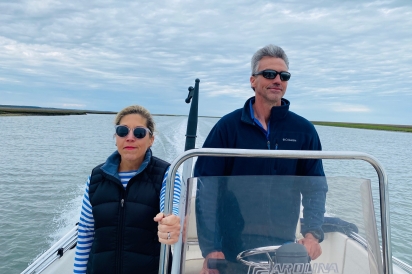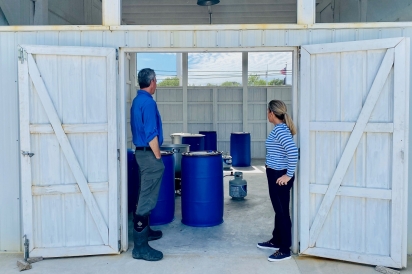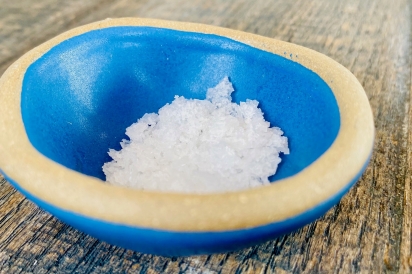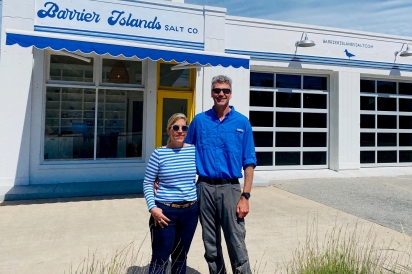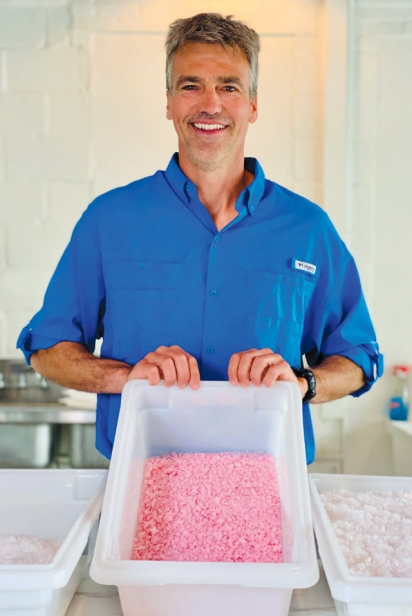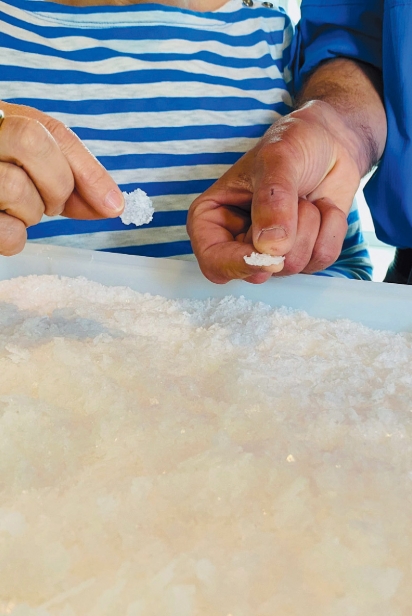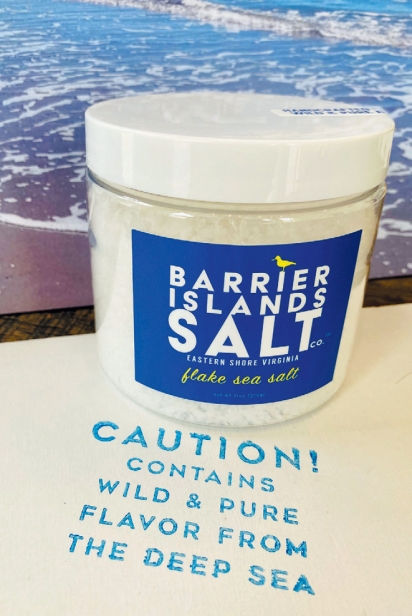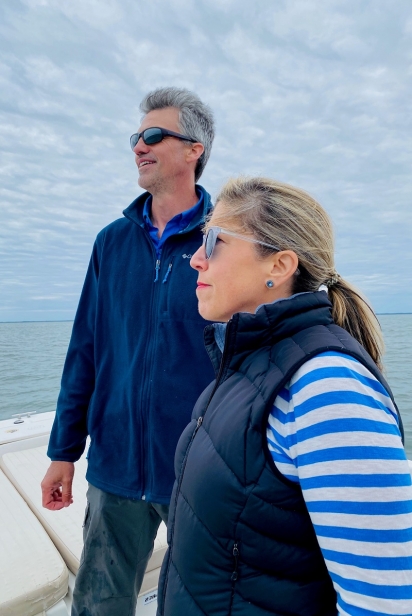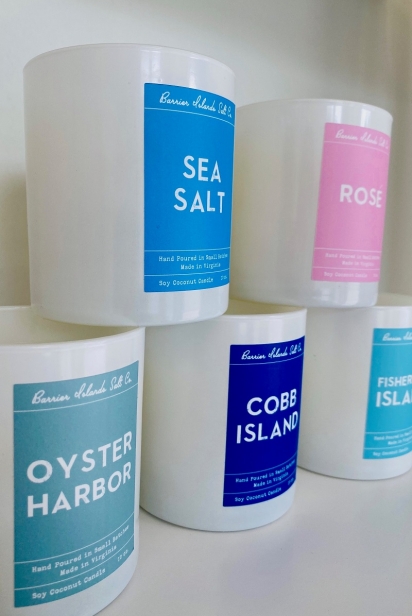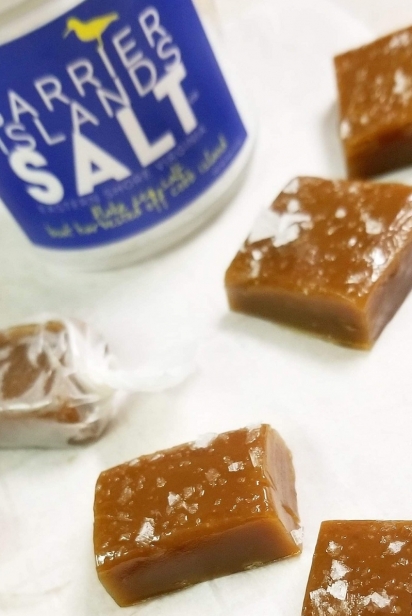Barrier Islands Salt Co.
There’s a magic spot eight miles off the coast of Virginia’s Eastern Shore where you can find buried crystal treasures at the mouth of the Atlantic Ocean. Once one of the world’s most precious commodities, these crystals determined not only the worth of prominent people in power, but of whole empires and of civilizations around the globe.
Ancient trade routes were carved out for this precious mineral and the world’s great cities profited from its high value at market. Wars were fought and won over this natural resource. It was once as valuable as gold and in some countries physically molded into currency. We’ve learned over the centuries that this crystalline compound is essential to life and it plays a critical role in maintaining the health of the human body. Today, it has over 14,000 uses and is an essential building block in the chemical industry. The highly processed version of this once scarce and sought after mineral can now be found in almost every home on earth. We use these white crystals daily to season and preserve our food and we don’t think twice about its rich history.
This precious commodity? Salt.
Here in the Commonwealth of Virginia, salt was not only one of our state’s first heritage foods, but one of our nation’s first aquacultural products, along with fish and shellfish. Captain John Smith mentions his salt house on Smith Island in The Generall Historie of Virginia, New England, and the Summer Isles, first published in 1624. While you’ll find a few sea salt companies scattered around the United States, no saltworks have operated in Coastal Virginia since the 1700’s.
That is until Anna and David Lee of Barrier Islands Salt Co. started harvesting and refining Virginia sea salt 10 years ago. Over that time, they perfected their salt making method, called open pan evaporation, following in the steps of some of the artisanal masters in Europe. By creating a chef-grade sea salt here on the Eastern Shore, they’re able to offer local residents and restaurants across Delmarva a sustainable, eco-friendly salt.
I was fortunate enough to join Anna and Dave on the boat ride out to their sweet spot, an inlet called Sand Shoal flowing between Cobb and Wreck Island, where Cobb Bay meets the great Atlantic. Dave, a retired US Coast Guard Senior Chief working now as a Lead Boat Captain and Research Specialist for the Virginia Coast Reserve Long-Term Ecological Research program, talked about how the water is what sets Barrier Islands Salt apart from all others in America. After spending so much time transporting students and scientists from all over the world around the barrier islands and through the waters that surround them, he’s seen firsthand how conservation efforts have preserved these pristine coastal habitats.
While he talked, I couldn’t help but close my eyes and let the salt spray coat my face and hands. I crawled a little further into my coat, content in the chill and the cloud cover, with the wind blowing all around us. As we drew closer to the area where Dave gathers the saltwater, I pointed toward the terns and the brown pelicans fishing from the sky. Then, twenty or so dolphins surrounded us, their silky gray dorsal fins peeking out from beneath the green-blue ripples of water, methodically moving in circles. The three of us watched in awe, hoping to get a better peek (and picture) and feeling helpless to really capture what it looks or feels like to be so close to such an incredible mammal.
The boat engine stopped and Dave announced that this was the magic spot, eight miles off the coast, in 65-foot-deep water, in the 130,000 acre Virginia Coast Reserve. This was the same area where he and Anna have collected their seawater since July 2015. This was where they found their crystal clear ocean water, the source of their wild and pure flaked finishing salt. While Dave poured the water into the 55 gallon buckets, I was mesmerized by its transparency and wondered what the world would look like today if the whole ocean was this clean.
Thanks to the dedication and service of The Nature Conservancy, who own and preserve fourteen of the undeveloped barrier and marsh islands along Virginia’s Eastern Shore, the waters that surround them are some of the most beautiful in the world. In fact, the Virginia Coast Reserve is the largest stretch of coastal wilderness left on the East Coast. It is the home and nesting place for many birds and wildlife and also serves to protect local communities against storm surge and sea level rise. The filtration from the eelgrass meadows and oyster reefs are what help keep the water so clear.
With the lids on and the buckets strapped in, we set off once more. The blur of the marsh, the birds prattling above, and the wet wind sent my head spinning. This was a piece of Virginia’s aquacultural heritage found again. This was history in the making, a new form of farming the water for the Delmarva region. Dave and Anna were changing the world, in their own little way. They were bringing back to life an old tradition, a new future for local artisanal salt. I was overwhelmed by the wonder of it all.
Back in Oyster, at the docks, we talked a bit about Nathan Cobb, the local lore and history surrounding him and his family, his island and the neighboring Wreck Island.
After purchasing the island for $100 and fifty bushels of salt, Cobb made his money salvaging shipwrecks and kept a public house where guests staying over could go gunning and fishing together with the locals. While Dave continued regaling us with stories, I was distracted by the bright blue and white architectural building we pulled up to. I didn’t ask how much they spent renovating the historic building, but I silently guessed he didn’t pay for the construction in sea salt like Nathan Cobb.
At the Barrier Islands Salt Company’s base of operations, every detail is accounted for. The perfectly placed logos, the blue shadow of an oystercatcher in the sky, and the yellow door under a clean scalloped awning screamed of Anna’s expertise. A professional marketer, local business founder and food entrepreneur in DC with Gone Native Foods among other projects, Anna designed every element of their branding and managed the renovation of their building. While buckets were unloaded in the back, I wandered to the front of the converted 1936 Texaco Gas Station where the retail shop would be.
Not only do Anna and Dave offer jars of their flaked finishing salt for sale, but I found little vials of their two main varieties as wedding favors for coastal brides. I opened the lids of candles and drank in the scents hand poured by local candle makers using their salt. I tasted pink sea salt infused with rosé wine from Chatham Vineyards. My fingers grasped a small blue hand-crafted salt cellar and I peeked inside an open gift box headed to a very special customer. Next to the box was a stamped note saying “CAUTION! contains wild & pure flavor from the deep sea.”
Noises next door stirred me from the spot where I stood at the counter and I went to investigate. Dave was unloading the seawater and hand-pouring it through a water filter into kettles. Over a propane heat source, the water is brought to boiling and heated until it becomes a brine, a high concentration solution of salt in the water. From there, the solution is bucketed from the kettle, filtered once more and then poured into a rectangular evaporation pan. Once inside the pan, it’s gently heated in order to keep the surface of the brine from moving.
The exquisite crystals, white and bright, form into flakes on the liquid surface and then fall to the floor of the pan. Again and again, these salt flakes form and then drop onto the layers below. Using a perforated scoop, Dave gently lifts the flakes up from the bottom and places them into salt drying trays. The trays are then stored inside the drying room where a dehumidifier gently pulls the moisture out from the sea salt. Anna and Dave rake each tray by hand with a fork during the drying process. Once dried, they hand-sort the flakes, inspecting and grading each one before packaging.
When Dave took out the trays of salt for me to take a closer look, I couldn’t really grasp what I was seeing. It looked like buried crystal treasure or the kind of snow you dream about as a child, sparkling white in the light. It looked unreal, almost like a magical dust. I held it in my hand wondering how something like this could come to be, though I watched the process with my own two eyes.
And I’m not the only one fascinated with its texture or its wild and pure flavor. Anna was packing one pound bags of it for regional chefs.
Chef Gregory at the Inn at Perry Cabin in St. Michaels, Maryland, uses Barrier Islands Salt regularly in his masterful dishes and desserts. Laura Davis, coastal food blogger on Chincoteague Island makes her salted caramels with it, and Brown Dog Ice Cream down in Cape Charles sprinkles it over their distinct flavors, in cups and cones. News has traveled up and down The Shore and into various parts of the Commonwealth and Maryland. More and more local artisanal shops are carrying Barrier Islands Salt Co. products and the list keeps growing.
Anna and Dave are looking ahead to opening up a shop in Cheriton, but until it’s ready you can find their flaked finishing salt and other goods and wares at their online shop, at local retailers, and at Pearl Market in Cape Charles every Saturday from 9 am to noon, through October.
So make a plan to go see them in person or find a local retailer near you that stocks up on their salt. You won’t regret being a part of history, sourcing sustainably, and tasting the wild and pure flavors of the last coastal wilderness on this side of the Atlantic.
Barrier Islands Salt Co.
21209 N. Bayside Rd. Cheriton, Virginia
Facebook Instagram
Barrier Islands Salt Co. shop at Pearl Market
4198 Latimer Siding Rd. Cape Charles, Virginia
Saturday Market, 9am-12pm



